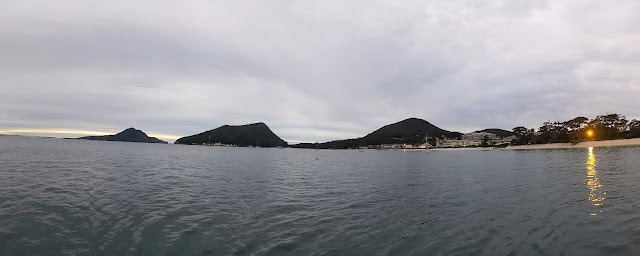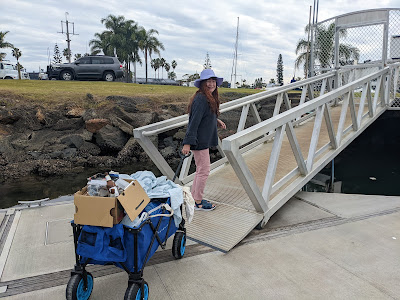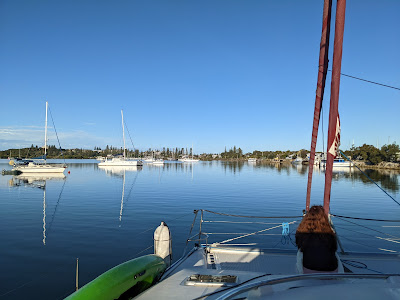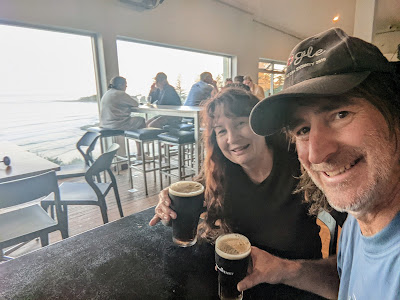There are two kinds of people who sail in winter: the few who relish its joys and the many who are just passing through, headed for warmer climes.
Occasionally, you can be both. Within hours of setting sail from Shellharbour, NSW and turning north, we spotted our first humpback whale. It was love at first splash. Each southern winter, the entire east coast of Australia comes alive as these gentle giants migrate north from their Antarctic feeding grounds in search of warmer waters to mate and calve. We were graced with their presence for the next nine days, enjoying regular displays of breaching, tail flapping, spouting, and other forms of cetacean acrobatics.
For this stage of our voyage, for the first time, there would be just the two of us—Merri and me—so we decided to sail only by day and avoid those tedious night watches. As a bonus, we would enjoy all of the beautiful coastal scenery and we would not miss a single whale.
Our day of departure arrived and disaster! Arriba’s starboard engine started but would not move out of neutral. Boats don’t like being ignored and Arriba had been sitting unused for two months. If the throttle cable was broken, ordering and installing a replacement would cost us days. Instead, I hoped that the cable had merely seized and might be coaxed into submission. I detached the cable from both ends (i.e., from the throttle controls as well as from the engine), sprayed in copious amounts of WD-40, and proceeded to whack the end with a rubber mallet. Depressingly, it resisted my furious pounding. I continued and, after another minute, I sensed slight movement. Finally, the cable started moving freely. Hurray! I quickly reattached the cable and we got underway at 10:41. As we bade farewell to Shellharbour, I made a mental note to order a spare cable. We dropped anchor at Jibbon Beach at 17:07, just in time to witness a glorious sunset.
For our second day, I planned to bypass Sydney and head straight to Pittwater, necessitating an early start. Those plans were shattered when the mainsail’s clew blew apart a few miles north of Botany Bay. I called former crew member Liam who recommended a sailmaker, Ian Short Sails. As luck would have it, they could collect our sail from the Botany Bay Yacht Club (BBYC). The only problem was that the BBYC is on the inland side of the Captain Cook Bridge. I calculated the clearance and it would be a very tight fit with our 15.4m mast. We waited for low tide and passed under the bridge, our VHF antenna touching its underside as we went (video).
Approaching the Captain Cook Bridge.
Passing under the Captain Cook Bridge.
Ian Short Sails were marvelous and turned around the sail repair within 12 hours, complete with an explanation for the clew failure. When I had re-rigged the mainsail in Hobart (after the previous repair), I had carelessly tied the reefing line too far back on the boom. Sails can tolerate enormous downward forces but not lateral forces. Since Hobart, every time I reefed I was literally pulling the mainsail apart. It was another lesson learned the hard way.
Sea travel has always been dictated by the turning of the tides. Usually, a stranded vessel is waiting for high tide to depart but in Arriba’s case, we were waiting for the low tide. This time, we were not worried about whether or not we would clear the bridge. At 13:16 we aimed for the center of the bridge and passed under with confidence. An hour later, we exited Botany Bay and headed north. The light had faded by the time we entered Pittwater and turned south for Coasters Retreat, where we anchored at 17:15. The mooring area is in deep water, and finding a spot to anchor in darkness was tricky, as most boats were barely visible.
The following day, as we headed for the open ocean, we passed Great Mackerel Beach, a wide sandy beach with few moorings. Although not marked as an anchorage, it would have been much easier to approach in darkness and equally suitable in south-westerlies or light southerlies.
After eking out barely 80 nautical miles over two days, I was keen to cover some distance. Alas, the winds never exceeded 8 knots so we had no choice but to motor sail if we were to make decent progress. We covered 74 nautical miles before pulling into Port Stephens and, once again, it was dark by the time we anchored. Shoal Bay was an easy anchorage to approach at night, though.
Shoal Bay, Port Stephens.
Five days of motoring had made a big dent in our fuel reserves, so it was time to find a fuel dock. The nearest was at the Port Macquarie Marina, 29 nautical miles away, which we reached at 10:54. We decided to treat ourselves to the luxury of the marina for one night and took advantage of the laundromat, shops, and the nearby Little Turkey restaurant, recommended to us by the welcoming marina worker.
Laundry run, Port Macquarie.
We set out at 06:50 the following day to make the most of the daylight. In my haste, I missed a turn in the channel and briefly ran aground, to the amusement of people fishing on a nearby wharf. Twenty minutes later, we re-entered the Pacific Ocean and were greeted by overcast skies, light rain, and fickle winds. Motoring at least provided us with the opportunity to troll and we soon caught our first fish. At 11:50, a whale surfaced less than 100m directly in front of us. I’m certain that it sensed our position and we maintained our course without colliding. Seventy nautical miles later we arrived at Coffs Harbour, as the last rays of sun vanished over the land. Coffs Harbour, which is an official Australian port of entry, is a wide-open anchorage that is easy to approach in all conditions. We anchored for the night but there is also a full-service marina.
Diving whale.
Yamba anchorage.
Pacific Hotel, Yamba.
Yamba boasts a well-protected anchorage and convenient public docks with easy dinghy access. There was still plenty of daylight left so we went ashore and meandered through town until we reached the Pacific Hotel, with its awesome ocean views. After a drink, we returned to Arriba for dinner on board. Yamba has no shortage of dining options, though.
We were again greeted by cloudy weather and calm conditions the next day. After exiting the Clarence River at 07:17, we set our course for Ballina, 34 nautical miles away. An hour later we were able to sail at 6.5 knots in 8-knot WNW winds. By 10:00, the wind had picked up to 11 knots, boosting our speed to 7.2 knots. The sailing was not to last though, as shortly after passed Ballina at 12:30 the wind vanished. At 14:55, were abeam of Cape Byron, mainland Australia’s easternmost point. Almost six months earlier, we had passed South East Cape in Tasmania, Australia’s southernmost point. That made us two for four of Australia’s geographical extremities.
We anchored at Byron Bay at 15:50, a rolly anchorage that is only suitable in southwesterly or calm conditions. One look at the menacing shore break on Main Beach dashed any thoughts of going ashore. The easternmost end of the beach closest to the rocks looked like the best bet and I would have aimed for that spot if we had been desperate to go ashore. But we were content to remain on board.
Our tenth and final day since leaving Shellharbour brought more rain and bleak skies. We weighed anchor at 06:45 and enjoyed a 10-knot southwesterly for a couple of hours. At 11:00 we passed Cook Island and soon after entered Queensland waters. The towers of the Gold Coast, at first small protrusions in the distance, loomed into view and eventually dominated our portside view. At 13:56, we entered the Gold Coast Seaway, an impressive entrance that is easy in almost all conditions, then turned south. Thirty minutes later we were docked at the Southport Yacht Club, our home for the next few days.
Next stop, New Caledonia!
OVER
PS This was the fourth stage of our trip (7/2022). The earlier stages were: Wirrina Cove to Hobart (12/2021), Hobart to George Town (3/2022), and George Town to Shellharbour (4/2022). The story continues here.








Comments
Post a Comment